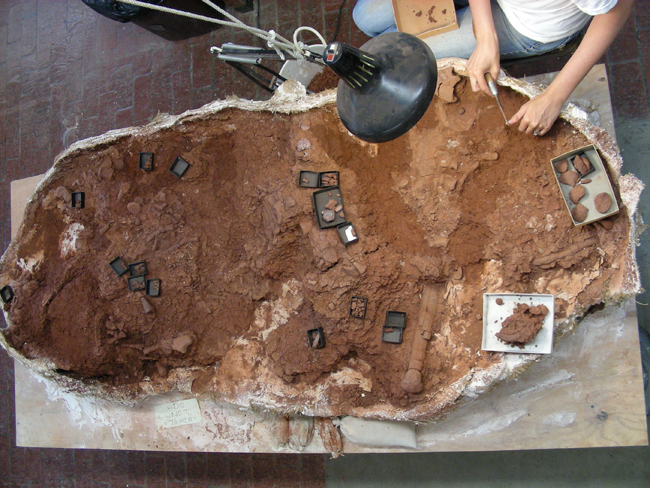[Recent Entries][Archive][Friends][User Info]
| March 6th, 2012 | |
|---|---|
| 06:54 pm [industrialterro] [Link] |
Angistorhinus Angistorhinus (meaning "narrow snout" or "hook snout") is an extinct genus of phytosaur known from the Late Triassic period of Texas and Wyoming, USA. It was first named by Mehl in 1913 and the type species is Angistorhinus grandis. Other species from Texas and Wyoming, A. alticephalus (Stovall and Wharton, 1936), A. gracilis (Mehl, 1915) and A. maximus (Mehl, 1928), are cospecific with the type species. Angistorhinus is known from the holotype UC 631, partial skull and lower jaws recovered from the Popo Agie Formation, Chugwater Group, Wyoming and from the associated paratype UM 531, a partial skull, TMM 31098-1, skull and lower jaws and ROM 7977, partial skull and lower jaws, recovered from the 'Pre-Tecovas Horizon' in the Dockum Group, Texas. A possible second species, A. talainti is known from the Triassic of Morocco. In 1995, Long and Murry created the new combination, Angistorhinus megalodon by synonymy for Brachysuchus. Hungerbühler and Sues (2001) hypothesised that Angistorhinus is a junior synonym of Rutiodon. However, in 2010 Michelle R. Stocker retained the validity of Brachysuchus and of A. grandis. Фитоза́вры (Phytosauria) — монотипический отряд вымерших пресмыкающихся из позднего триаса, относимый к архозаврам и включаемый в сборную парафилетическую группу текодонтов, или ячеистозубых. Окаменелости обнаруживались в отложениях верхнего триаса на территории Западной Европы, Северной Америки, и Азии. Отряд фитозавров включает единственное семейство Phytosauridae представители которого обитали в пресноводных водоёмах, в основном питались рыбой. Внешне и деталями строения очень схожи с крокодилами. Однако, большинство учёных рассматривают данное сходство как конвергенцию, впрочем существует мнение о том, что фитозавры были предками крокодилов. Крупные животные с длиной тела 5—6 метров. Имели удлинённое рыло с отнесёнными далеко назад ноздрями и глазницами обращенными вверх. Задние лапы были незначительно длиннее передних. Обладали хорошо развитым кожным панцирем. The phytosaur skull was characterized by three distinct morphotypes, which relate to feeding and habits and not (as was once thought) evolutionary relationships. These skull patterns are linked to characteristics of the dentition; specifically the differentiation or similarity of the teeth along the jaws. Dolichorostral ("long snouted") types have a long, slender snout and a large number of conical teeth that are the same throughout. These were most likely piscivorous, able to capture fast slippery prey, but not so good at tackling a land animal. Some examples are Paleorhinus, Rutiodon carolinensis, and Mystriosuchus. At one time it was believed that Paleorhinus and Mystriosuchus belonged to a distinct group of phytosaurs (subfamily of family Mystriosuchinae/Mystriosuchidae Huene, 1915) characterised by this adaptation, but it is now known that Mystriosuchus is actually more closely related to Pseudopalatus, an "altirostral" form (Hungerbühler, 2002). Brachyrostral ("short snouted") forms are the opposite, they have a massive, broad snout, and a very strong skull and jaws, with the front teeth like fangs for holding the prey, and the rear teeth blade-like for slicing the meat into chunks that can easily be swallowed (an animal with different types of teeth like this is called heterodont). These were powerful animals specialised for feeding on strong struggling prey, such as terrestrial animals that come to the water to drink. Examples of this type are Nicrosaurus and Smilosuchus Altirostral ("high snouted") animals are intermediate between the two. They had heterodont dentition but not as extremely developed as the brachyrostral type. Angistorhinus and Pseudopalatus are typical examples here. These were most likely generalist feeders. Modern crocodilians exhibit a similar morphological diversity, for example the broad snouted altirostral alligator and the long snouted dolichorostral gavial. Phytosaurs were even better armoured than crocodiles, protected by heavy bony scutes (often found as fossils), and the belly reinforced with a dense arrangement of gastralia (abdominal ribs). Despite their great similarities in appearance and lifestyle, there are still a number of minor differences that distinguish phytosaurs from true crocodiles. For one thing, the phytosaur ankle structure is much more primitive than that of any crocodile. Also, phytosaurs lack the bony secondary palate that crocodiles have that enables them to breathe even when the mouth is full of water. It is possible however that phytosaurs had a fleshy palate, as many Mesozoic crocodiles are presumed to have had. Finally, and most noticeably, phytosaurs had nostrils placed near or above the level of the eyes, in contrast to crocodiles where the nostrils are near the end of the snout. This adaptation may have developed to allow them to breathe while the rest of the body was submerged. In a 2001 study of the biomechanics of the dinosaur Albertosaurus's teeth, William L. Abler also examined a phytosaur's teeth, finding that it had had serrations so fine that they resembled a crack in the tooth. Albertosaurus had similarly crack-like serrations, but, at the base of each serration Abler discovered a round void which would have functioned to distribute force over a larger surface area. This void, termed an ampulla, would hinder the ability of the "crack" formed by the serration to propagate through the tooth. The phytosaur was found to lack adaptations for preventing its dental "cracks" from propagating. Abler examined another sort of prehistoric predator, Dimetrodon, and found that it lacked adaptations for guarding against crack propagation as well.
Ископаемые останки (1, 2, 3, 4):
Tags: Вымершие рептилии, Триас, архозавроморфы, архозавры, диапсиды, круротарзы, текодонты, фитозавры |




